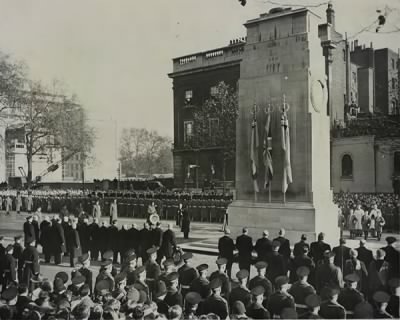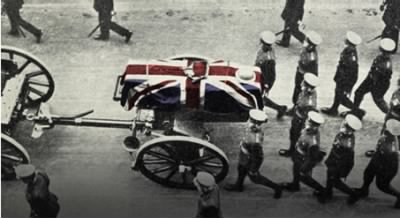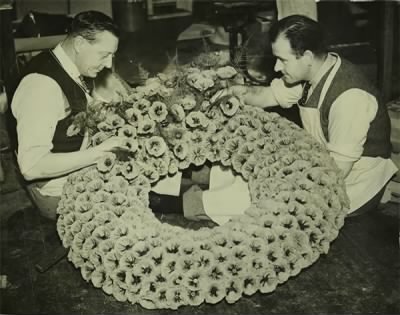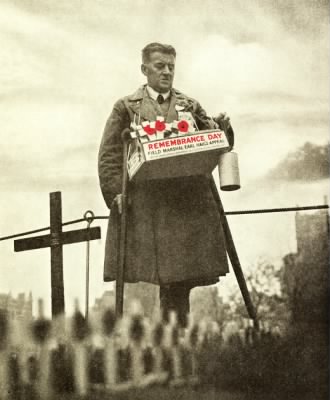Remembrance Day
The first Remembrance Day was conducted in 1919 throughout the Commonwealth and Britain. Learn more about this event along with the history of the Cenotaph, the Unknown Warrior and why we wear a poppy.
In the aftermath of the Great War, Britain needed a way to remember those who died.
The Tomb of the Unknown Warrior buried at Westminster Abbey and the Cenotaph would become the focus for the nation to remember, particularly on 11th November, the anniversary of the Armistice.
(Remembrance Day, where H.M. the King laid his wreath on the Cenotaph)
What is Remembrance Day?
The first Remembrance Day was conducted in 1919 throughout the Commonwealth and Britain. Originally called Armistice Day, it commemorated the end of hostilities of the Great War in 1918. It came to symbolise the end of the war and provide an opportunity to remember those who had died.
In a letter published in the London Evening News on the 8th of May 1919, Australian journalist Edward George Honey proposed a respectful silence to remember those who had given their lives in the Great War. This suggestion was brought to the attention of King George V, and on the 7th of November 1919, four days before the first anniversary of Armistice Day (as it was originally named), King George V announced that a two-minute silence would be observed, and thus began Remembrance Day as we know it today:
"All locomotion should cease, so that, in perfect stillness, the thoughts of everyone may be concentrated on reverent remembrance of the glorious dead." - King George V
Two features of that first Armistice Day are still central to today’s commemoration: the two-minute silence and the Cenotaph in Whitehall. Prime Minister David Lloyd George asked architect Edwin Lutyens to design a structure for a ‘Peace Day’ parade in London; his initial design was sketched on the back of a napkin, and from that, a temporary version of the Cenotaph was erected. On the first-ever Remembrance Day, nearly 15,000 troops took part; however, many veterans refused to participate in what they saw as a 'militaristic celebration'. Cenotaph means 'empty tomb' and the first wood and plaster structure by Edwin Lutyens was replaced by a permanent structure built from Portland stone between 1919 and 1920 by Holland, Hannen & Cubitts.
So, what was Remembrance Day like in the early years? There were certainly church services, much the same as today, and the Forces’ chaplain spoke at the Cenotaph. It was also a day not just for remembrance, but for looking forward, and throughout the country meetings were held, attended by thousands, in support of the League of Nations. Local war memorials were erected throughout the 1920s. At annual ceremonies the names of the dead were read out loud, and so the awful silence was accompanied by a vocal acknowledgement.
After the end of the Second World War in 1945 Armistice Day became Remembrance Day to include all those who had fallen in the two World Wars and other conflicts. Now, this anniversary on the 11th November is used to remember all the people who've fought and died in wars since World War I including soldiers from WWII, and other conflicts including the Falklands War, the Gulf War, and conflicts in Afghanistan and Iraq.
On Remembrance Day we take 2 minutes to silently pay respects to the millions of heroes who served for and protected their country. We also thank all those who are currently serving, especially those deployed overseas, facing new dangers day after day.
The history of The Cenotaph
The Cenotaph that stands in Whitehall, London was first built with wood and plaster and intended only as a temporary structure for the Peace Day Parade on 19th July 1919. The Parade was one of the most impressive spectacles ever witnessed by Londoners and the world. Nearly 15,000 troops took part in the march, led by the victorious Allied commanders.
The Cenotaph was built at the request of the then Prime Minister Lloyd George (1863-1945), and designed and built by Sir Edwin Lutyens, who had provided many of the designs for the cemeteries being created by the Imperial War Graves Commission. Cenotaph which means ‘empty tomb’ in Greek provided an immediate focus for public grief following the Great War of 1914 – 1918 and is dedicated to ‘The Glorious Dead’ which gave a place of mourning for those who relations, friends, husbands, brother and sons who died in the war without a known grave. The Cenotaph proved so popular that a permanent replacement was commissioned. Designed by Sir Edwin Lutyens, the permanent structure was built from Portland stone by Holland, Hannen & Cubitts, replacing Sir Edwin Lutyens' earlier wood-and-plaster cenotaph in the same location. It was unveiled by King George V (1865-1936) on Armistice Day - 11th November 1920. The unveiling ceremony was part of a larger procession which saw the procession of the Unknown Warrior on his final journey to burial at Westminster Abbey. Originally, it was intended to commemorate the victims of the First World War, but is now used to commemorate all of the dead in all wars in which British servicemen and women have fought. The Cenotaph was designated a Grade I listed building on 5th February 1970.
The Unknown Warrior: gone, but never forgotten
The Unknown Warrior is a powerful symbol that embodies a host of contradictions. He is an ordinary soldier, but one who has been given a place of extraordinary honour; he has no name, yet every family whose relative never returned from the Great War feels that he belongs to them; he represents the losses and horror of war, but also the glory of dying for King and Country; and finally, he is doomed to remain ‘unknown’ for all of time, yet is famous around the world. According to Mark Adkin’s ‘The Western Front Companion’, the idea for this shrine to every man who would never have a proper named grave was conceived by Reverend David Railton, M.C., in 1916. Having just completed a burial service near Armentières, the Reverend was returning to his billet, his heart full of the cares of war, when he happened to pass a solitary grave, adorned with a simple wooden cross. On this modest marker was written, “An unknown soldier of the Black Watch”. Something about the gesture of respect deeply touched him, so much so that he was moved to write to Douglas Haig, suggesting that the soldier’s body be returned to Britain and honoured as a symbol of all like him. It was only much later in October 1920 that the idea was taken up and championed by the Dean of Westminster, as well as David Lloyd George, the Prime Minister. The Commonwealth War Graves Commission stated in 2009 that 526,816 British and Commonwealth Great War soldiers have no known grave, but are named on various memorials, and of those, 338,955 have never been buried at all, while 187,861 do have graves but have not been identified.
Four of the most devastating battles for Britain occurred at Aisne, the Somme, Arras and Ypres. To give some idea of the scale of devastation, Norman Ferguson’s ‘The First World War: a Miscellany’ asserts that 54,435 soldiers with no known grave are commemorated on the Menin Gate at Ypres alone, with another 72,203 British and South African soldiers named on the Thiepval Monument at the Somme. All missing British men – assuming their bodies have in fact been found – lie under a simple headstone with an epitaph composed by the great writer Rudyard Kipling, whose own son, John, was lost at the Battle of Loos: “A soldier of the Great War, known unto God”. Each of these men likely had a family at home, and every one of their families suffered the heartache of never knowing precisely where their loved one had ended up, and never having a headstone to visit and lay flowers upon. It was to ease this frustration and grief that the tomb of the Unknown Warrior was created. The anonymity of the buried serviceman was a crucial element of the whole concept. In this way, the body would simultaneously represent no particular fallen serviceman, and stand in for all of them. That being the case, great care was taken to ensure that nobody could have a clue who the warrior might be. Mark Adkin explains that one body only was exhumed at each of the Somme, Aisne, Arras and Ypres battlefields on November 9th 1920, with the servicemen chosen having no evidence upon their person of their name, what their unit was, or even whether they belonged to the Army, Air Force or Navy; they were, however, identified as British or Commonwealth and Dominion by means of being found in a grave containing pieces of British equipment, such as a belt or boots, and being exhumed where only British members of the Allied forces had fought. All four were taken to the same location, a Nissen hut converted into a chapel at St Pol, where they were laid on stretchers and covered with the Union Jack. One of the four was then chosen at random by Brigadier General Wyatt, the General Officer in charge of troops in France and Flanders, who attended the chapel in the company of Lieutenant General Gell of the Directorate of Graves Registration & Enquiries. The other three were returned for reburial, while a service was held for the Unknown Warrior, who was then taken to Boulogne to begin the long journey home to Dover. The burial was a sight to be seen. Eyewitness accounts by James Bone, at the time London editor of the Manchester Guardian, and Francis Perrot appear in Part 48 of ‘The Great War, I Was There’ magazine, published August 29th 1939, and can be read in our Historic Documents archive.
The Gun-carriage bearing the coffin of the Unknown Warrior
King George V, flanked by the Prince of Wales and the Duke of York, acted as chief mourner; this was only fitting, when one considers the fact that each and every individual who had gone off to war had done so in the king’s name. A further gathering of dignitaries, waiting to meet the coffin at the Horse Guards’ Parade, represented the forces and governments of Britain, her Commonwealth and Dominions, as well as the churches of those countries. The pall bearers were all Admirals, Generals and Field Marshalls, but a silent column of discharged British soldiers of all ranks, regiments, nationalities and services followed the coffin, in company with a host of 100 men who had been awarded gallantry awards, including 74 holders of the Victoria Cross, the bravest of the brave, who nonetheless came to pay their respects to this unidentified man. Surrounded by a heavy mist, the mourners waited as first King George placed a wreath on the coffin, then the Archbishop of Canterbury recited the Lord’s Prayer. At the first stroke of 11:00 by Big Ben the king pushed a button that dropped two outsized Union Jacks that were covering the new permanent Cenotaph, a monument to all who had fought for Britain, both named and unnamed. As the final stroke died a two-minute silence descended, then the Last Post was sounded and the procession continued on to Westminster Abbey – the traditional resting place of kings, dignitaries and members of the aristocracy. A service then followed, conducted by the Dean of Westminster and attended by Queen Mary, Queen Alexandra and the queens of Spain and Norway, as well as a profusion of ex-servicemen and over 1,000 war widows. ‘The Western Front Companion’ describes a deferential arrangement by which those women who had given both husbands and all their sons were at the front, those who had lost only or all sons next, followed by those who had lost husbands. The coffin, wrapped in a purple funeral pall, was lowered into a grave in the floor of the cathedral and topped with soil brought specially from Ypres, the first spoonful of which was thrown in by the king himself. When the grave was covered over, it would be topped with a plaque of black Belgian marble, edged with red poppies and inscribed using melted-down cartridge cases.
BENEATH THIS STONE RESTS THE BODY OF A BRITISH WARRIOR
UNKNOWN BY NAME OR RANK
BROUGHT FROM FRANCE TO LIE AMONG THE MOST ILLUSTRIOUS OF THE LAND
AND BURIED HERE ON ARMISTICE DAY 11 NOV: 1920, IN THE PRESENCE OF HIS MAJESTY KING GEORGE V
HIS MINISTERS OF STATE
THE CHIEFS OF HIS FORCES
AND A VAST CONCOURSE OF THE NATION
THUS ARE COMMEMORATED THE MANY MULTITUDES WHO DURING THE GREAT WAR OF 1914-1918 GAVE THE MOST THAT MAN CAN GIVE LIFE ITSELF
FOR GOD
FOR KING AND COUNTRY
FOR LOVED ONES HOME AND EMPIRE
FOR THE SACRED CAUSE OF JUSTICE AND THE FREEDOM OF THE WORLD
THEY BURIED HIM AMONG THE KINGS BECAUSE HE HAD DONE GOOD TOWARD GOD AND TOWARD HIS HOUSE
After the service, ambulances full of the blind or grievously wounded servicemen came to honour their friends who had never returned home at all. However, according to the ‘The Great War, I was there’, the moving part of the occasion was only just beginning. Once the official service was over and the king had gone, soldiers, widows and remaining figures of authority alike fell in to file past the coffin and pay their respects. Frances Perrot says, “The V.C.s broke the solemn ranks and became just comrades looking their last on a comrade… the rich women and the poor – for all the open grave meant exactly the same thing.” What that thing was is explained beautifully in a tribute written by James Bone:
“We know you well, dear comrade. We know that to you these honours would seem the most gigantic of jokes if they were paid to yourself. Your guffaws would burst the coffin. But you understand us. It is hundreds of thousands we are honouring in your person. Because you were nameless and were forgotten we choose you. You represent them all.”
This is the secret of why the Tomb of the Unknown Warrior so moved the British people, and still does today. For all anyone knew, it was their loved one, their friend, their brave colleague who was so tantalisingly close, and so very honoured. That is why, according to ‘The First World War’ by Ian F W Beckett, 40,000 people visited to pay their respects on that first day alone. In the days that followed up to the 27th of November, 1.5 million would make the pilgrimage to Westminster Abbey, to weep and lay flowers. Meanwhile, other nations created their own shrines in imitation, with France holding its own commemoration of the Unknown Warrior on the same day as the British burial.
Why we wear a poppy
Here are some facts about the occasion and why we wear a poppy:
Armistice Day was held on the Monday of the week which November 11th fell from 1921 to 1930. Member of Parliament for Comox-Alberni Mr Alan Neill introduced a bill to observe Armistice Day only on November 11th and a House of Commons bill changed the name to Remembrance Day, with the first Remembrance Day taking place on November 11th, 1931.
(Ex Servicemen making Poppies - Hutton/Getty Collection)
- The Red Poppy was first created as a symbol of Remembrance by an American, Miss Moina Belle Michael a professor at the University of Georgia. She was inspired on 9th November, 1918 by the poem 'In Flanders Fields' by Canadian John McCrae, with its opening lines referring to the thousands of poppies that were the first flowers to grow in the churned-up earth of the battlefields and on soldiers' graves. She wrote a poem in response called “We Shall Keep the Faith” and vowed to always wear a red poppy as a symbol of Remembrance for those who served in the war. Moina Michael threw her efforts into campaigning to get the poppy adopted as a national Remembrance symbol. Two years later, the National American Legion's conference proclaimed the poppy as such. Among those at the conference was Madame Anna E Guérin, of France, who saw poppy sales as a way of raising money for the benefit of the French people, especially the orphaned children, who were suffering as a result of the war. Having organised the sale of millions of poppies made by French widows in the United States, in 1921 she sent her poppy sellers to London. Field Marshall Douglas Haig, a senior commander during WWI and a founder of Earl Haig's British Legion Appeal Fund (later The Royal British Legion), was sold on the idea (as were veterans' groups in the Commonwealth). So, in 1921, the newly-established legion sold its first Remembrance poppies. And so, the tradition began.
- Moina Belle Michael became known as “The Poppy Lady” through her campaigning for the Memorial Poppy.
- Although the Poppy Appeal has its origins in World War I, where it became a symbol of Remembrance and hope, it is still just as relevant today. That's because the money raised goes towards looking after serving and ex-servicemen and women, and their dependents who are in need - financially or otherwise.
- 9 million poppies were sold by 11th November 1921. The poppies sold out almost immediately and that first ever 'Poppy Appeal' raised over £106,000; a considerable amount of money at the time. This was used to help WW1 veterans with employment and housing. The demand for poppies in England was so high that few were reaching Scotland. Earl Haig's wife established the 'Lady Haig Poppy Factory' in Edinburgh in 1926 to produce poppies exclusively for Scotland.
- Selling poppies proved so popular that in 1922 the British Legion founded a factory - staffed by disabled ex-servicemen - to produce its own. Today over 45 million poppies a year are crafted, in an operation involving just 40 full-time employees - many of whom are disabled ex-servicemen.
- The poppy may be worn at commemorative events throughout the year, such as anniversaries of significant battles, a memorial service, and other similar occasions.
- The Legion suggests that the poppy is worn on the left lapel of a garment and as close to the heart as possible.
- The Queen lays the first wreath during the national ceremony at the Cenotaph in Whitehall.
- Other charities sell poppies in different colours, each with their own meaning but all to commemorate the losses of war. White poppies, for example, symbolise peace without violence and purple poppies are worn to honour animals killed in conflict
(ex-Private H.E. Day of the 15th Hussars who lost a leg during the war Nov 11th 1938 selling wooden crosses)
Don't forget to post (and share) a lasting commemoration to your ancestors, or loved one's on our Dedication Wall today. It's completely free to use, plus you can search for other relatives too!




